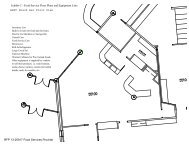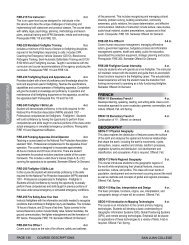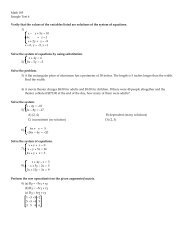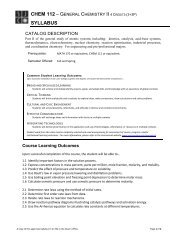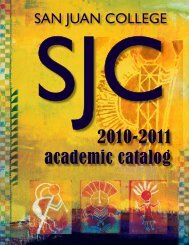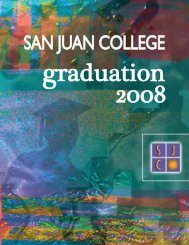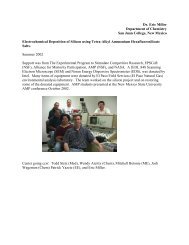AQIP 2007 Systems Portfolio - San Juan College
AQIP 2007 Systems Portfolio - San Juan College
AQIP 2007 Systems Portfolio - San Juan College
Create successful ePaper yourself
Turn your PDF publications into a flip-book with our unique Google optimized e-Paper software.
odies. State performance reports and legislativedirectives are additional means of determiningdepartmental data needs.Beyond the institutional-level means of determiningdepartment and unit data needs, there are severaldecentralized processes unique to individual academicschools. For example, the School of Health Sciencesuses processes such as licensure exam success ratesand employer satisfaction with graduate preparation.7P3 The State of New Mexico places importance onidentifying and collecting system-wide data. Thisenables SJC to compare its efforts with other NewMexico public institutions on a number of levelsimportant to higher education, State legislators andother decision-making bodies.<strong>San</strong> <strong>Juan</strong> <strong>College</strong> has individual programs accreditedby various national accrediting bodies includingNational League for Nursing, Accreditation Board ofEngineering & Technology, Commission onAccreditation in Physical Therapy Education,Association of Collegiate Business Schools andPrograms, National Automotive Technicians EducationFoundation, and American Dental Association,American Veterinary Medicine Association,Commission on Dental Accreditation.Information is gathered from a variety of sources:• Individual programs that are accredited by nationalaccrediting bodies provide criteria which must bemet in terms of course content, instructorqualifications, equipment, program assessmentmethods, and institutional support.• A weekly newsletter published by the NMHEDused to disseminate information such as statewidemeetings, policy changes, and reports.• NMHED selected national peer institutions tocompare specified measures for performancefunding and accountability in government.• New Mexico Community <strong>College</strong> peer institutionsmeasures for performance funding andaccountability to the New Mexico LegislativeFinance Committee.• Benchmark data for financial measures bothnational and statewide• Other institutions to analyze program costs,instructional costs, professional developmentcosts, and efficient use of public dollars.• Facility benchmark measures compared withagencies outside higher education regarding utilityand building costs that allows the college tooperate efficiently.7P4 Performance measures and budget and personnelupdates are presented at the monthly Board meeting.SJC also analyzes information by groups vested to themeasures. For example, when the college gathersinformation regarding student satisfaction of services,Student Services will analyze the information andimplement operational plans to improve the measures.SJC shares information and data regarding overallperformance in a variety of ways. Listing thesemethods from the broadest to the narrowest: <strong>San</strong> <strong>Juan</strong><strong>College</strong> web site; SJC Communicator distributedcountywide and weekly news clips; convocations whichinclude budget and personnel updates, strategic andoperational plans, and new programs; legislativeupdates; publications and Learning and StudentServices retreats twice a year and monthly President’sCabinet meetings.SJC also analyzes information and data throughparticipation in the Higher Learning Commission’sAcademic Quality Improvement Program (<strong>AQIP</strong>), withaction projects and annual updates. The feedback ishelpful in assessing progress on action projects.7P5 Each department is charged on an annual basis todevelop plans which are in response to the <strong>College</strong>’sestablished strategic goals and initiatives.Departmental activities and individual Charters ofAccountability are then developed to support anassociated strategic directive (see Figure 8.2). SJCensures that faculty/staff and educational programprocesses are aligned to organizational levelperformance analysis through (1) organization wideparticipation, (2) access to data and (3) review andfeedback loops. For example, the New Program andProgram Review process are central to ensuringalignment of <strong>College</strong> objectives regarding studentlearning. The Grants Development Process andQuality Grants Review process are central to ensuringgrants development is aligned with the Strategic Planand goals and objectives and agency requirements arebeing met.Information is shared through departmental and<strong>College</strong> meetings and SJC website (see 5P5).7P6 SJC recently completed the installation ofDatatel© Colleague ERP as a common repository forstudent information and data, human resourceinformation and data, and finance information anddata. SJC partners with SunGard for management andsupport of all of its information technology systemsthrough the Office of Technology Services (OTS). Thispartnership provides the college with highly trainedpersonnel and in-depth corporate resources. OTSplaces all campus PCs on a four year cycle and keepsall software updated with current versions, maintainsfirewalls and virus protection, and data integrity andreliability through lists and tables, drop-down menus,and data standards. In addition, OTS requires eachdepartment responsible for the information and data tocontrol security access through OTS. The OTS HelpDesk service is a primary tool used for assuringavailability of an effective information system.Satisfaction results are presented in Table 3.10).7P7 KPIs are reviewed annually by senior leadershipto determine if they are still viable measures fordemonstrating institutional effectiveness as well as toadjust target levels based on historic data an intendedimprovement. SJC collects and analyzes the followingmeasures of effectiveness on a regular basis:<strong>AQIP</strong> Category Seven: Measuring Effectiveness



